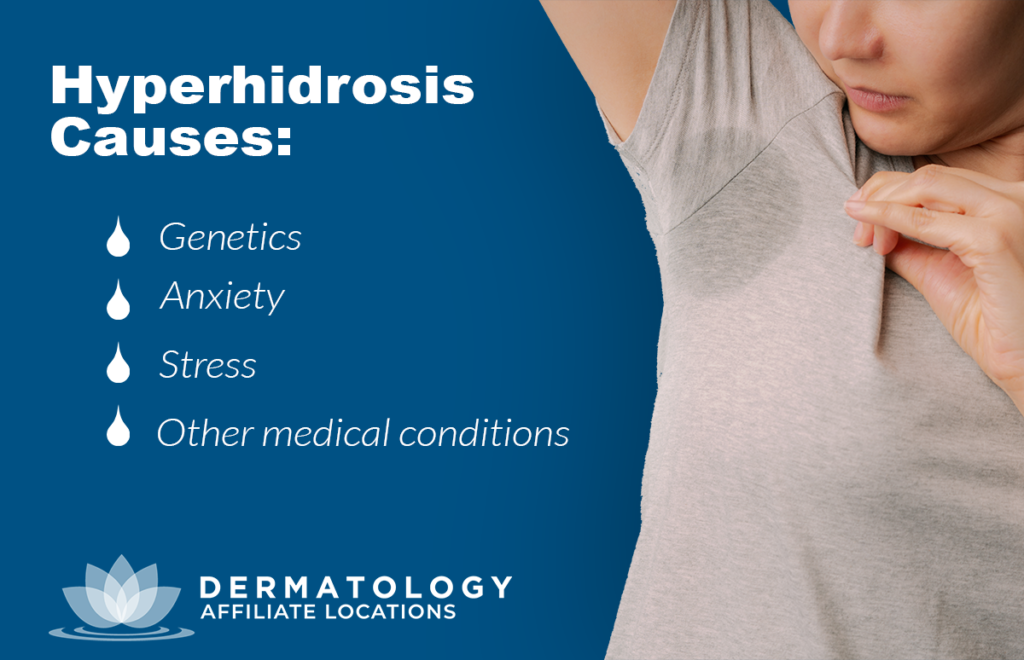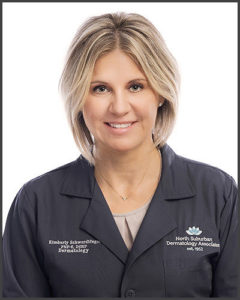Hyperhidrosis: What You Should Know & Treatment Options
Those suffering from hyperhidrosis don’t just experience excess sweating during the hot summer months, they can experience it all year long. Unfortunately, it can be a cumbersome and difficult skin condition to deal with.
Here to answer all of our questions about hyperhidrosis is Kimberly Schwerdtfeger, NP-C.
What is hyperhidrosis?
Hyperhidrosis is increased perspiration (excessive sweating) that’s not necessarily related to heat or exercise.
Hyperhidrosis tends to begin during adolescence and an estimated 7.8 million Americans have this condition.
Where does hyperhidrosis affect most?
Most commonly, hyperhidrosis presents in the armpits, face, hands, and feet are affected.
Besides disrupting normal daily activities, this type of heavy sweating can cause social anxiety and embarrassment. There are two forms of hyperhidrosis, primary or secondary.
What causes hyperhidrosis?
Primary hyperhidrosis, the most common, is often idiopathic focal sweating (unknown source of cause).
However, studies have indicated that a family history is fairly common with this type of disorder. Triggers of flares would be increased state of emotion, anxiety, stress, but also increased physical activity, heat and spicy foods.
Secondary hyperhidrosis is less common, in which sweating is more generalized and is associated with an underlying medical condition like a metabolic disorder, endocrine, neurologic and/or infection.
If there is a suspicion of secondary cause further investigation by a provider is needed.

How is hyperhidrosis diagnosed?
In order to diagnose the most common form of primary hyperhidrosis, 2 of the following need to be consistent; involvement of bilateral affected areas, impairs daily activities, episodes occur at least once per week, positive family history and or symptoms cease during sleep.
How to Treat Hyperhidrosis
There are several treatment modalities for primary focal hyperhidrosis which coincide with location and severity of perspiration.
The most common treatment is topical agents known as aluminum chloride and or topical glycopyrrolate. Most recently FDA approved is the 2.4% glycopyrronium cloth for axillary hyperhidrosis age 9 years and older, which is applied daily.
Another treatment would be oral glycopyrrolate, primarily used for sweating of the palms, soles and axillae. Even Botox (onabotulinumtoxin A) has also been used as a beneficial treatment.
Less common treatments, such as iontophoresis and Mira Dry have also been used, but are more difficult to be covered by medical insurance.
Because this condition is often underreported and can be impairing for many people, it’s important for those affected to seek help and realize that you’re not alone. If you feel like you may have this condition, please schedule an appointment with your nearest dermatology provider and seek proper treatment.
References
Brackenrich J, Fagg C. Hyperhidrosis. StatPearls {Internet}. http://www.ncbi.nlm.nih.gov/books/NBK459227/. Accessed 2020 May 11.
Haider A, Solish N. Focal hyperhidrosis: diagnosis and management. CMAJ. 2005 Jan 4;172 (1): 69-75 PubMed Id: 15632408
About Kimberly Schwerdtfeger, NP-C

Kimberly was born and raised in Wisconsin and resides in the Milwaukee area. After graduating from Concordia University in 2011, she obtained her Master’s degree as an Advanced Practice Nurse and is licensed to diagnose and treat in both Wisconsin and Illinois. She completed her Bachelor’s Degree in 1999 and has worked as an intensive care nurse for 12 years.
Kimberly has been with North Suburban Dermatology Associates since 2012 and has had exceptional dermatology teaching from her esteemed colleagues, Dr. Dubin and Dr. Solomon. She is a Board Certified Nurse Practitioner who specializes in all types of skin conditions with emphasis in both adolescent and adult acne, psoriasis including biologics and phototherapy, wart management, along with skin cancer detection and treatment. She also performs many cosmetic dermatologic procedures such as laser, botox, injectable fillers and chemical peels.

